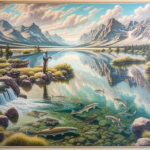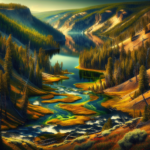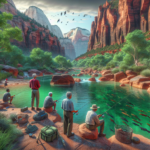Fishing in Great Basin National Park: Lakes, Rivers, and Reservoirs

Introduction
Did you know that Great Basin National Park is home to some of the most pristine and secluded fishing spots in the United States? Nestled in the heart of Nevada, this park offers anglers a unique opportunity to fish in high-altitude lakes, rivers, and reservoirs surrounded by breathtaking landscapes. In this article, we will explore the best fishing techniques, species information, top fishing spots, and essential gear for fishing in Great Basin National Park. Whether you’re a seasoned angler or a beginner, this guide will help you make the most of your fishing adventure in this stunning national park.
Background/Context
Historical or Cultural Significance
Great Basin National Park, established in 1986, is a relatively young national park but holds a rich history. The area has been inhabited by Native American tribes for thousands of years, and their fishing practices have been passed down through generations. The park’s waters have long been a source of sustenance and cultural significance for these communities.
Geographical Overview
Located in eastern Nevada, Great Basin National Park spans over 77,000 acres and features diverse landscapes, including high desert, alpine lakes, and ancient bristlecone pine forests. The park’s climate varies significantly with elevation, ranging from arid desert conditions at lower elevations to cooler, alpine conditions at higher altitudes. This diverse ecosystem supports a variety of fish species, making it a prime destination for anglers.
Key Points/Details
Fishing Techniques
Technique Overview
Fishing in Great Basin National Park can be done using various techniques, including fly fishing, spin fishing, and bait fishing. Fly fishing is particularly popular due to the park’s clear, cold waters and abundant insect life.
When and Where to Use
Fly fishing is most effective in the park’s rivers and streams, especially during the summer months when insect hatches are at their peak. Spin fishing and bait fishing can be used in both lakes and reservoirs, with early morning and late evening being the best times to fish.
Recommended Gear
- Fly Fishing: A 4-6 weight fly rod, floating line, and a variety of dry flies, nymphs, and streamers.
- Spin Fishing: A medium-light spinning rod, 6-8 lb test line, and a selection of spinners, spoons, and soft plastics.
- Bait Fishing: A medium spinning rod, 6-8 lb test line, and live bait such as worms or artificial bait like PowerBait.
Species Information
Species Overview
The primary fish species in Great Basin National Park include brook trout, rainbow trout, and Bonneville cutthroat trout. These species thrive in the park’s cold, clear waters and offer exciting challenges for anglers.
Best Practices
To successfully catch these species, use the following tips:
- Brook Trout: Found in high-altitude lakes and streams, brook trout are most active in the early morning and late evening. Use small dry flies or nymphs for fly fishing, and small spinners or spoons for spin fishing.
- Rainbow Trout: Common in both lakes and rivers, rainbow trout can be caught using a variety of techniques. Fly fishers should use dry flies, nymphs, and streamers, while spin fishers can use spinners, spoons, and soft plastics.
- Bonneville Cutthroat Trout: Native to the Great Basin region, these trout are found in select streams and lakes. Fly fishing with dry flies and nymphs is effective, as is spin fishing with small lures.
Location Information
Top Fishing Spots
- Baker Lake: A high-altitude lake accessible via a moderate hike, offering excellent brook trout fishing.
- Lehman Creek: A popular spot for rainbow and Bonneville cutthroat trout, with easy access from the main park road.
- Strawberry Creek: Known for its healthy population of brook trout, this creek is ideal for fly fishing.
Regulations and Licenses
Anglers must have a valid Nevada fishing license to fish in Great Basin National Park. Additionally, there are specific regulations regarding catch limits and seasonal restrictions. For example, the daily limit for trout is five fish, and certain areas may have catch-and-release requirements. Always check the latest regulations before fishing.
Seasonal Considerations
Seasonal Variations
Fishing conditions in Great Basin National Park change throughout the year. Spring and early summer offer excellent fishing as water levels rise and temperatures warm. Late summer can be challenging due to lower water levels and higher temperatures. Fall is another prime time for fishing, with cooler temperatures and active fish.
Best Times to Fish
The best times to fish in Great Basin National Park are early morning and late evening when fish are most active. Additionally, the months of May through September offer the most favorable conditions for fishing.
Events and Tournaments
Event Overview
While Great Basin National Park does not host large fishing tournaments, there are local events and community gatherings that celebrate fishing and outdoor activities. Check with the park’s visitor center for information on any upcoming events.
Preparation Tips
To prepare for a fishing event or tournament, ensure you have the appropriate gear, practice your techniques, and familiarize yourself with the fishing spots. Additionally, check the weather forecast and plan accordingly.
Tips and Best Practices
General Tips
- Always check the weather forecast before heading out.
- Use polarized sunglasses to spot fish and reduce glare.
- Practice catch and release to help preserve fish populations.
Avoid Common Mistakes
- Not checking local regulations: Always be aware of the latest fishing regulations and restrictions.
- Using the wrong gear: Ensure you have the appropriate gear for the species and fishing technique.
- Ignoring safety: Always prioritize safety, especially when fishing in remote or high-altitude areas.
Advanced Techniques
- Mastering the double haul cast for fly fishing to increase casting distance and accuracy.
- Using drop-shot rigs for spin fishing to target fish at specific depths.
- Experimenting with different fly patterns and sizes to match local insect hatches.
Gear and Equipment Recommendations
Essential Gear
- Fly rod and reel (4-6 weight)
- Spinning rod and reel (medium-light)
- Fishing line (6-8 lb test)
- Selection of flies, lures, and bait
- Polarized sunglasses
- Fishing vest or tackle box
Optional Gear/Upgrades
- Waders and wading boots for river fishing
- Fish finder for lake fishing
- High-quality fly tying kit for creating custom flies
Where to Buy or Rent
Local shops in nearby towns such as Ely and Baker offer fishing gear and supplies. Additionally, online retailers like Cabela’s and Bass Pro Shops provide a wide selection of fishing equipment.
Safety and Conservation
Safety Tips
- Always let someone know your fishing plans and expected return time.
- Carry a first aid kit and know basic first aid procedures.
- Be aware of wildlife, including snakes and bears, and know how to react if encountered.
- Stay hydrated and protect yourself from the sun with sunscreen and appropriate clothing.
Conservation Practices
- Practice catch and release to help maintain fish populations.
- Respect local wildlife and their habitats.
- Follow all fishing regulations and guidelines.
- Dispose of trash and fishing line properly to protect the environment.
Planning Your Trip
Accommodations
Great Basin National Park offers several camping options, including developed campgrounds and backcountry camping. Nearby towns such as Baker and Ely also have hotels and motels for those who prefer more comfortable accommodations.
Travel Tips
The park is accessible by car via U.S. Highway 50 and Nevada State Route 487. The nearest major airport is in Salt Lake City, Utah, approximately 230 miles away. Renting a car is recommended for exploring the park and its fishing spots.
Additional Activities
In addition to fishing, Great Basin National Park offers a variety of outdoor activities, including hiking, wildlife viewing, and stargazing. The park is home to the Lehman Caves, a popular attraction for guided tours.
Frequently Asked Questions (FAQs)
Do I need a fishing license to fish in Great Basin National Park?
Yes, a valid Nevada fishing license is required to fish in the park.
What is the best time of year to fish in Great Basin National Park?
The best time to fish is from May through September, with early morning and late evening being the most productive times of day.
Are there any catch limits or restrictions?
Yes, there are specific regulations regarding catch limits and seasonal restrictions. The daily limit for trout is five fish, and certain areas may have catch-and-release requirements.
What types of fish can I catch in Great Basin National Park?
The primary fish species include brook trout, rainbow trout, and Bonneville cutthroat trout.
Conclusion
Fishing in Great Basin National Park offers a unique and rewarding experience for anglers of all skill levels. With its diverse landscapes, pristine waters, and abundant fish species, the park is a true angler’s paradise. By following the tips and recommendations in this guide, you can make the most of your fishing adventure in this stunning national park. So pack your gear, get your fishing license, and head to Great Basin National Park for an unforgettable fishing experience.




